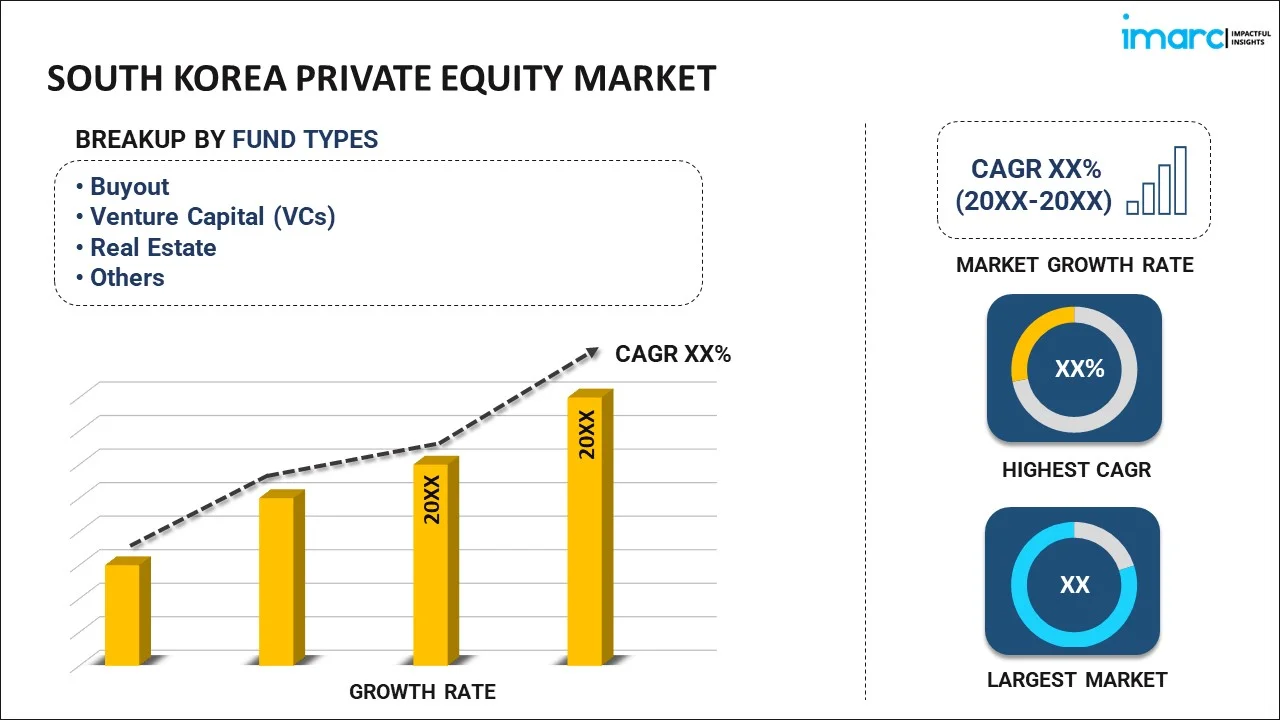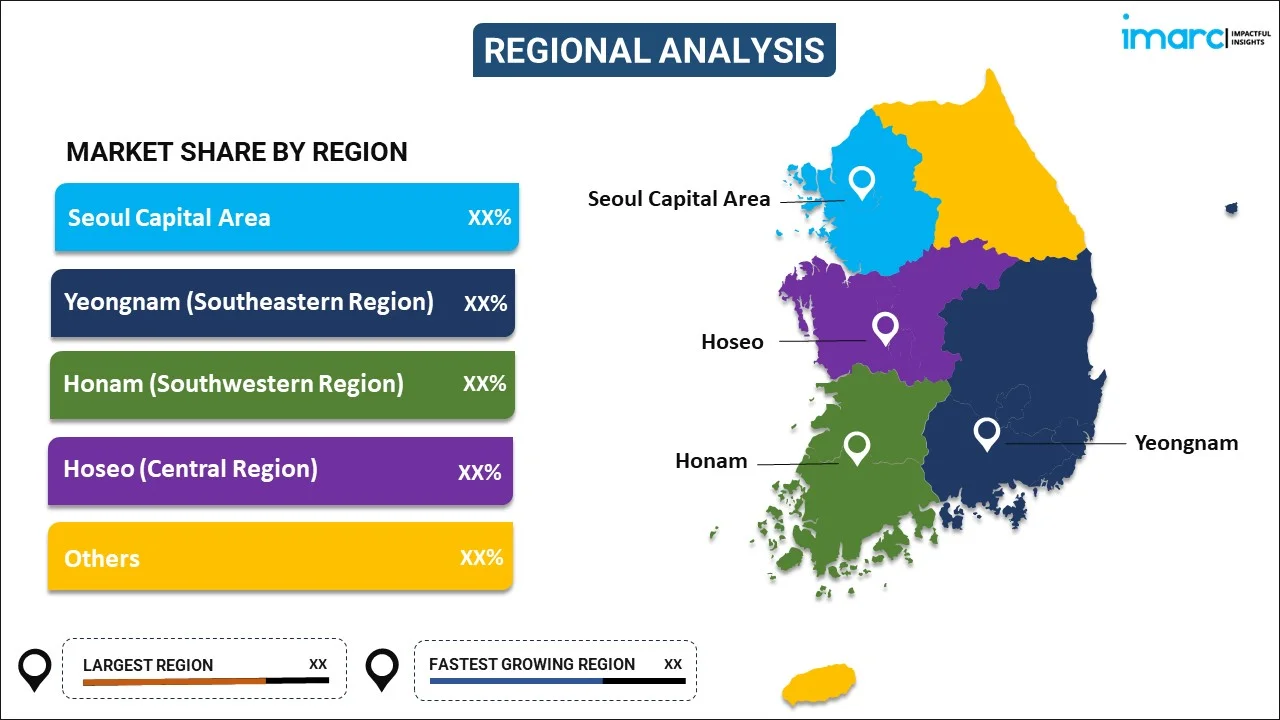
South Korea Private Equity Market Report by Fund Type (Buyout, Venture Capital (VCs), Real Estate, Infrastructure, and Others), and Region 2025-2033
South Korea Private Equity Market:
South Korea private equity market size reached USD 14,998.9 Million in 2024. Looking forward, IMARC Group expects the market to reach USD 34,769.2 Million by 2033, exhibiting a growth rate (CAGR) of 9.8% during 2025-2033. The growing focus of companies to secure long-term capital that is not easily accessible through conventional financing channels is primarily driving the market growth across the country.
|
Report Attribute
|
Key Statistics
|
|---|---|
|
Base Year
|
2024 |
|
Forecast Years
|
2025-2033
|
|
Historical Years
|
2019-2024
|
| Market Size in 2024 | USD 14,998.9 Million |
| Market Forecast in 2033 | USD 34,769.2 Million |
| Market Growth Rate (2025-2033) | 9.8% |
South Korea Private Equity Market Analysis:
- Major Market Drivers: The growing number of high-net-worth individuals, institutional investors, and specialized firms is further bolstering the market growth. Besides this, the pursuit of substantial returns over specific investment periods, usually five to seven years, is also propelling the South Korea private equity market growth.
- Key Market Trends: The South Korean government has been implementing policies to support private equity investment, including regulatory reforms and incentives to attract foreign investors, which is further proliferating the market's growth. Moreover, the technology and innovation sectors, including fintech and biotech, are attracting significant interest due to their growth potential and the country’s strong focus on technological advancements, thereby further driving the market demand.
- Competitive Landscape: The South Korea private equity market analysis report has also provided a comprehensive analysis of the competitive landscape in the market. Also, detailed profiles of all major companies have been provided.
- Geographical Trends: Increasing interest in tech startups and innovation-driven sectors, along with a growing focus on ESG (Environmental, Social, and Governance) investments in Seoul, is driving the market's growth. Moreover, the Honam region has seen increasing private equity interest due to its strong focus on agriculture, traditional industries, and emerging sectors, such as biotechnology and tourism.
- Challenges and Opportunities: The high competition and rigorous regulatory environment among key players are hampering the market's growth. However, South Korea’s robust economic growth and technological advancements present opportunities for private equity investment in various sectors, including technology, healthcare, and green energy.
South Korea Private Equity Market Trends:
Economic Growth
The rising economic growth and an expanding GDP are significant drivers for the South Korean private equity (PE) market. For instance, according to Statista, in 2023, South Korea's real GDP increased by roughly 1.36% compared to the previous year. As South Korea’s economy grows, new investment opportunities emerge across various sectors. Private equity firms are attracted to these opportunities as they seek to invest in companies with high growth potential. These factors are further positively influencing the South Korea private equity market forecast.
Growing Corporate Sector
South Korea is home to numerous large and innovative companies, especially in the technology, manufacturing, and consumer sectors. For instance, according to an article published by HRM Asia, as of the end of 2020, the country had 6,013,000 enterprises, a 17.8% increase over the previous five years. Similarly, according to Statistics Korea, 276,000 new companies were established in the first quarter, excluding those tied to real estate. The presence of high-quality assets and growth opportunities in these sectors attracts private equity investors looking for high returns. These factors are further contributing to the South Korea private equity market share.
Changing Demographics
South Korea’s aging population and changing consumer preferences are driving growth in sectors such as healthcare, senior living, and consumer goods. For instance, according to Statista, in 2023, there were nearly 2 million people aged 65 years and older in Gyeonggi Province, South Korea. Seoul followed with about 1.7 million. The total number of people aged 65 and older was around 9.7 million in 2023. Private equity firms are investing in these areas to capitalize on emerging trends and opportunities. These factors are augmenting the South Korea private equity market demand.
South Korea Private Equity Market Segmentation:
IMARC Group provides an analysis of the key trends in each segment of the market, along with forecasts at the country and regional levels for 2025-2033. Our report has categorized the market based on fund type.
Breakup by Fund Type:

- Buyout
- Venture Capital (VCs)
- Real Estate
- Infrastructure
- Others
The report has provided a detailed breakup and analysis of the market based on the fund type. This includes buyout, venture capital (VCs), real estate, infrastructure, and others.
According to the South Korea private equity market outlook, buyouts involve acquiring a controlling interest in a company, often with the intention of restructuring or growing the business to enhance its value. South Korea has a number of mature, established companies that are ripe for buyouts. These companies often have stable cash flows and solid market positions, making them attractive targets for buyout firms looking to implement operational improvements or strategic growth plans. Moreover, venture capital involves investing in early-stage companies with high growth potential, typically in exchange for equity. Besides this, real estate investments involve acquiring, developing, or managing properties for income generation or capital appreciation. There is strong interest in commercial real estate, including office spaces, retail centers, and logistics facilities, driven by the expansion of businesses and e-commerce.
Breakup by Region:

- Seoul Capital Area
- Yeongnam (Southeastern Region)
- Honam (Southwestern Region)
- Hoseo (Central Region)
- Others
The report has also provided a comprehensive analysis of all the major regional markets, which include Seoul Capital Area, Yeongnam (Southeastern Region), Honam (Southwestern Region), Hoseo (Central Region), and others.
According to the South Korea private equity market outlook report, the Seoul Capital Area, which includes Seoul, Incheon, and Gyeonggi Province, is the economic and financial hub of South Korea. It’s the most active region for private equity due to its concentration of businesses, advanced infrastructure, and high economic output. Moreover, Yeongam is located in the southeastern part of South Korea, which is not as economically prominent as the Seoul Capital Area. The region is best known for its agricultural and industrial activities. Private equity interest here might be lower compared to more economically vibrant regions, but there could be opportunities in specific sectors like regional development projects or local manufacturing.
Competitive Landscape:
The South Korea private equity market research report has also provided a comprehensive analysis of the competitive landscape in the market. Competitive analysis such as market structure, key player positioning, top winning strategies, competitive dashboard, and company evaluation quadrant has been covered in the report. Also, detailed profiles of all major companies have been provided.
South Korea Private Equity Market News:
- August 2024: South Korea's Yellow Umbrella issued a request for proposal for domestic private equity fund managers. Managers must oversee a fund of at least 200 billion won to be eligible for the first commitment.
- July 2024: Hahn & Co, a South Korean private equity firm formed by former Morgan Stanley banker, raised $3.4 billion for a new buyout fund.
- March 2024: KKR, a private equity firm, collaborated with Weave Living to invest in rental housing properties in South Korea.
South Korea Private Equity Market Report Scope:
| Report Features | Details |
|---|---|
| Base Year of the Analysis | 2024 |
| Historical Period | 2019-2024 |
| Forecast Period | 2025-2033 |
| Units | Million USD |
| Scope of the Report | Exploration of Historical Trends and Market Outlook, Industry Catalysts and Challenges, Segment-Wise Historical and Predictive Market Assessment:
|
| Fund Types Covered | Buyout, Venture Capital (VCs), Real Estate, Infrastructure, Others |
| Regions Covered | Seoul Capital Area, Yeongnam (Southeastern Region), Honam (Southwestern Region), Hoseo (Central Region), Others |
| Customization Scope | 10% Free Customization |
| Post-Sale Analyst Support | 10-12 Weeks |
| Delivery Format | PDF and Excel through Email (We can also provide the editable version of the report in PPT/Word format on special request) |
Key Questions Answered in This Report:
- How has the South Korea private equity market performed so far and how will it perform in the coming years?
- What has been the impact of COVID-19 on the South Korea private equity market?
- What is the breakup of the South Korea private equity market on the basis of fund type?
- What are the various stages in the value chain of the South Korea private equity market?
- What are the key driving factors and challenges in the South Korea private equity?
- What is the structure of the South Korea private equity market and who are the key players?
- What is the degree of competition in the South Korea private equity market?
Key Benefits for Stakeholders:
- IMARC’s industry report offers a comprehensive quantitative analysis of various market segments, historical and current market trends, market forecasts, and dynamics of the South Korea private equity market from 2019-2033.
- The research report provides the latest information on the market drivers, challenges, and opportunities in the South Korea private equity market.
- The study maps the leading, as well as the fastest-growing, markets. It further enables stakeholders to identify the key country-level markets within the region.
- Porter's five forces analysis assists stakeholders in assessing the impact of new entrants, competitive rivalry, supplier power, buyer power, and the threat of substitution. It helps stakeholders to analyze the level of competition within the South Korea private equity industry and its attractiveness.
- The competitive landscape allows stakeholders to understand their competitive environment and provides insight into the current positions of key players in the market.
Need more help?
- Speak to our experienced analysts for insights on the current market scenarios.
- Include additional segments and countries to customize the report as per your requirement.
- Gain an unparalleled competitive advantage in your domain by understanding how to utilize the report and positively impacting your operations and revenue.
- For further assistance, please connect with our analysts.

 Inquire Before Buying
Inquire Before Buying
 Speak to an Analyst
Speak to an Analyst
 Request Brochure
Request Brochure
 Request Customization
Request Customization



.webp)




.webp)












